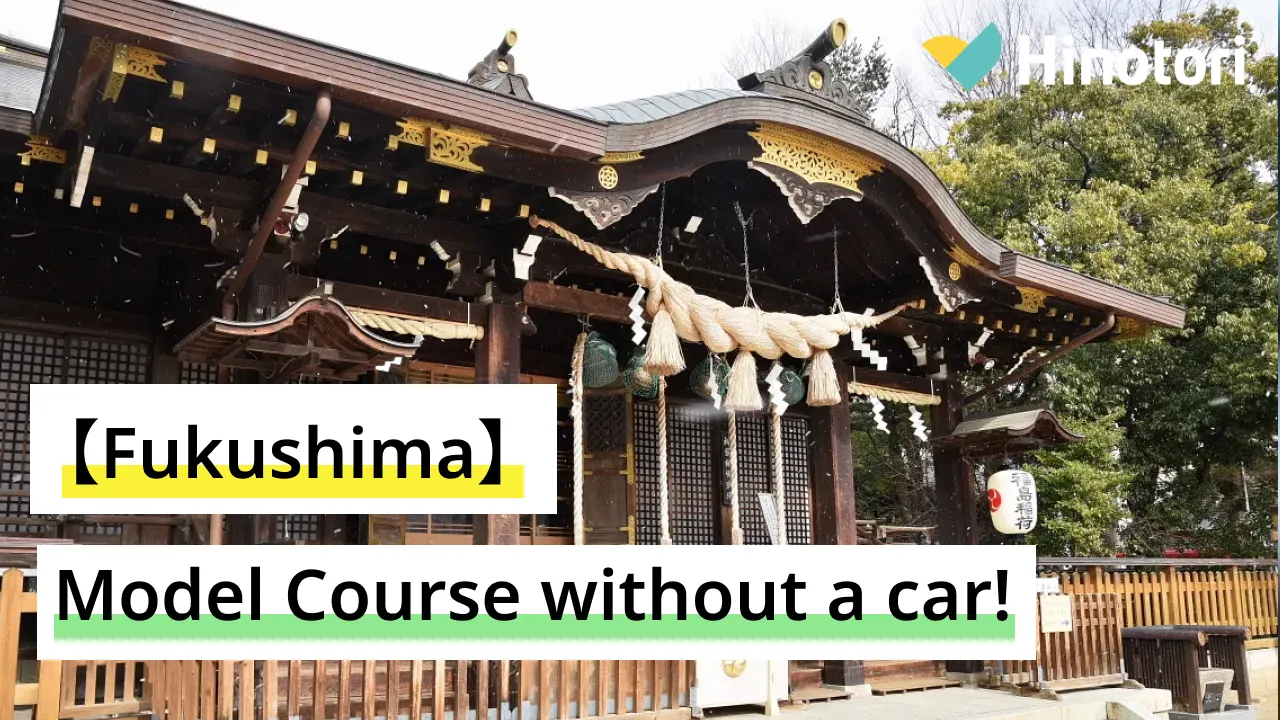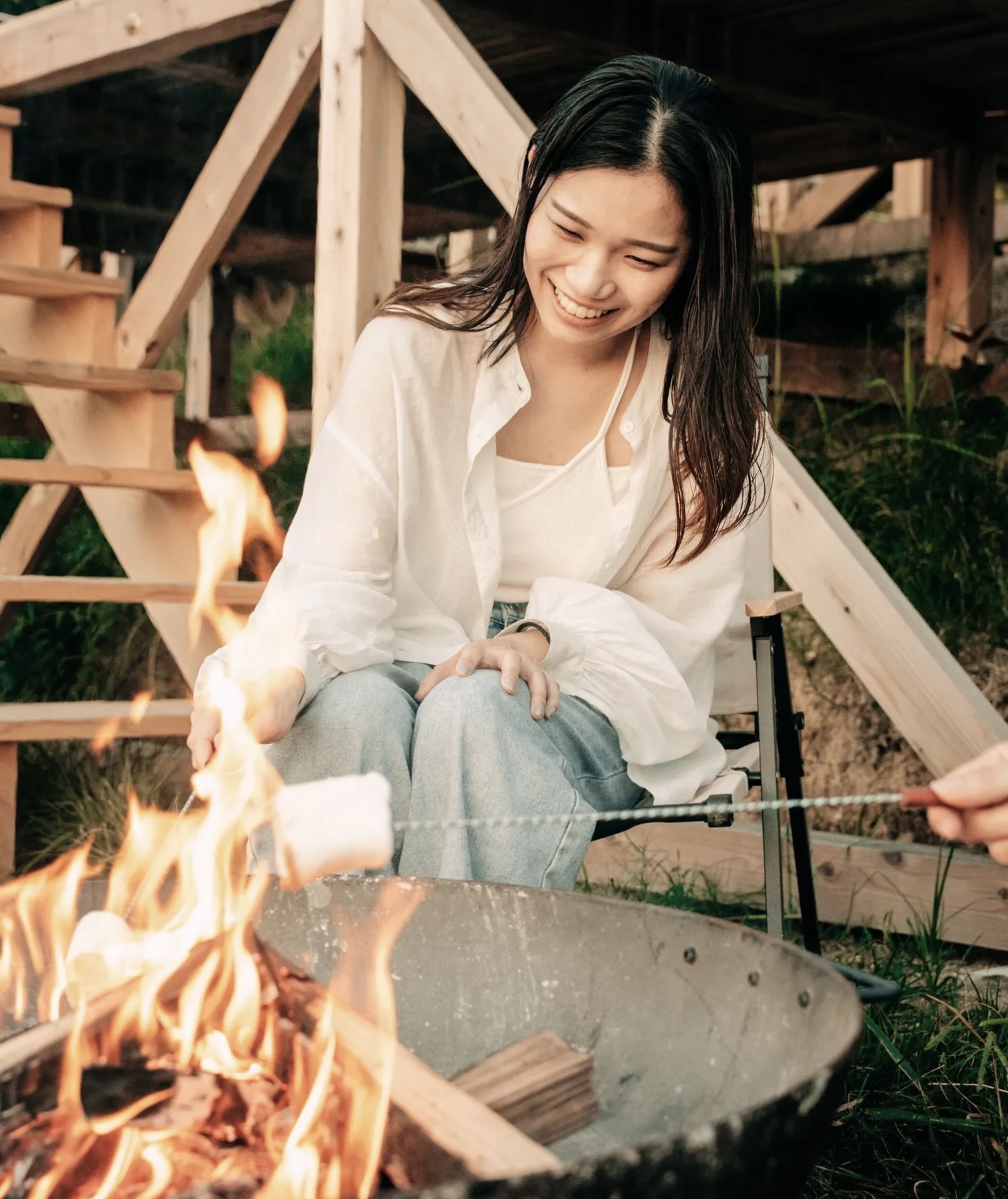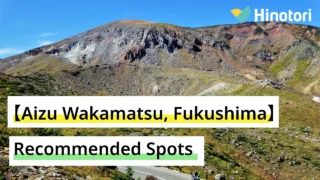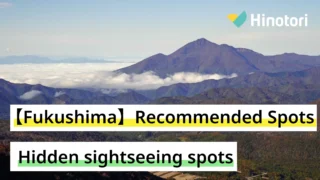Fukushima Prefecture is a tourist destination packed with natural beauty and historical charm. Even if you don’t have a car, you can still enjoy it to the full in just one or two days by train or bus. In this article, we will introduce a model course for enjoying Fukushima Prefecture without a car, taking in the area around Fukushima Station, scenic spots, and hot spring resorts.
Fukushima Prefecture is a tourist destination packed with natural beauty and historical charm. Even if you don’t have a car, you can still enjoy the area to the full in just one night and two days by using trains and buses. In this article, we will introduce a model course for sightseeing in Fukushima that you can enjoy without a car, taking in the area around Fukushima Station, scenic spots, and hot spring resorts! The plan is packed with highlights, including the beautiful scenery of Hanamiyama Park and Goshikinuma, historical spots in Aizu Wakamatsu, and superb gourmet food. We will explain in detail about efficient means of transport and recommended routes, so please use this as a reference for your trip!
- Fukushima can be enjoyed without a car! A 2-day, 1-night model course
- Day 1: Tour of the Fukushima Station area and scenic spots
- Tourist Spots around Fukushima Station|Fukushima Inari Shrine / Koseki Yuji Memorial Hall
- Strolling through Hanamiyama Park (cherry blossoms in spring, autumn leaves in autumn)
- Mystical Scenery: Hiking the Goshikinuma Lakes (Urabandai Area)
- Delicious Gourmet! Lunch at Kitakata Ramen restaurants (Sakanai Shokudo, Makoto Shokudo, etc.)
- Day 2: A trip to Fukushima to enjoy the hot springs, history and culture
- Tips for enjoying your visit to Fukushima even more
- Summary|A 2-day, 1-night trip to Fukushima that you can enjoy even without a car
- Fukushima can be enjoyed without a car! A 2-day, 1-night model course
- Day 1: Tour of the Fukushima Station area and scenic spots
- Tourist Spots around Fukushima Station|Fukushima Inari Shrine / Koseki Yuji Memorial Hall
- Strolling through Hanamiyama Park (cherry blossoms in spring, autumn leaves in autumn)
- Mystical Scenery: Hiking the Goshikinuma Lakes (Urabandai Area)
- Delicious food! Have lunch at a ramen restaurant in Kitakata (Sakanai Shokudo, Makoto Shokudo, etc.)
- Day 2: A trip to Fukushima to enjoy the hot springs, history and culture
- Perfect for a morning stroll|The thatched-roof houses of Ouchi-juku (an Edo-era post town)
- One of Japan’s three great hot-spring resorts! Day trip bathing at Higashiyama Onsen
- Aizu Wakamatsu Sightseeing|Feel the history at Tsurugajo Castle
- Finish off with a sauce katsudon! Enjoy the famous Aizu gourmet food (famous restaurants: Nakajima, Hakukujishokudo)
- Tips for enjoying your visit to Fukushima even more
- Summary|A 2-day, 1-night trip to Fukushima that you can enjoy even without a car
Fukushima can be enjoyed without a car! A 2-day, 1-night model course

Fukushima Prefecture is a tourist destination packed with natural beauty and historical charm. Even without a car, you can still enjoy it to the full over a 2-day, 1-night stay by using public transport. Starting from Fukushima Station, you can make good use of trains and buses to efficiently tour the tourist spots. In particular, there are many places of interest in the Fukushima City, Aizu Wakamatsu and Urabandai areas.
Fukushima’s appeal lies in its beautiful scenery that changes with the seasons, its historic sites, and its delicious local cuisine. In spring, you can enjoy the cherry blossoms at Hanamiyama Park, and in autumn you can enjoy the changing leaves, and the area shows a different face in each season. There are also many spots where you can feel the history of the area, such as Tsurugajo Castle in Aizu Wakamatsu and Ouchi-juku, and there are also plenty of cultural experiences to enjoy.
In addition, you shouldn’t miss the hot spring resorts in Fukushima. There are many hot spring ryokans where you can take a day trip and relax, perfect for relieving the fatigue of your travels. If you use public transport, you can move around smoothly and enjoy sightseeing to the full. Please refer to the model course we will introduce from now on and experience the charm of Fukushima.
The charm of Fukushima sightseeing|Why you can enjoy it even without a car
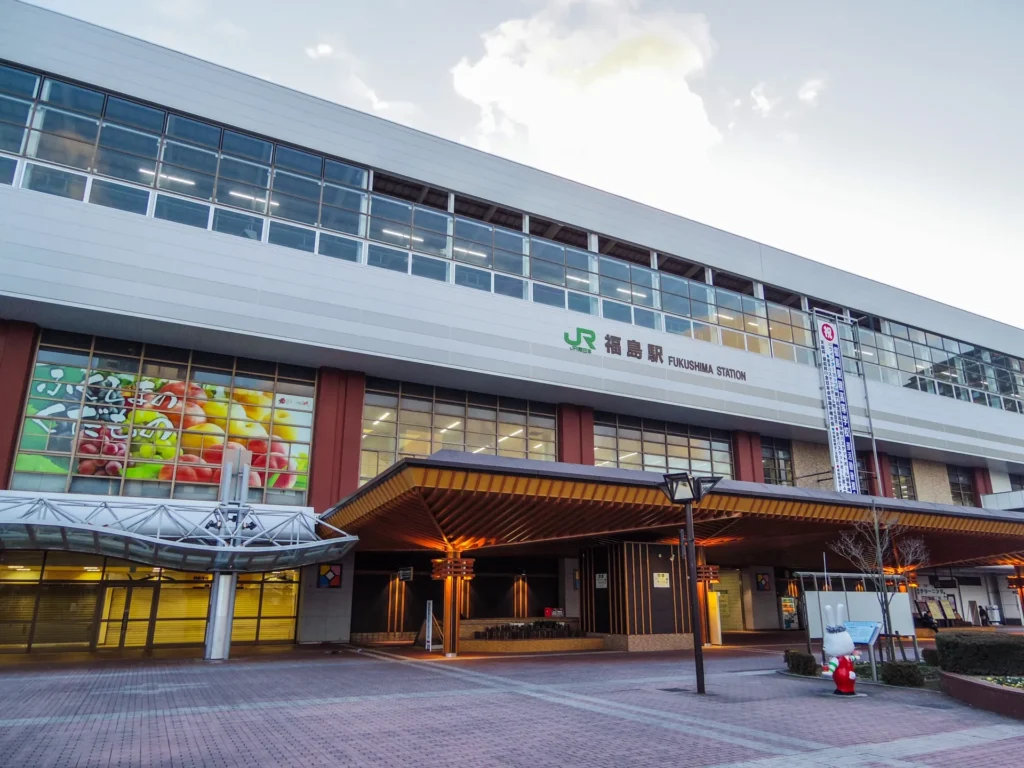
Fukushima Prefecture is a tourist destination packed with natural beauty and historical charm. Even without a car, you can still enjoy the full appeal of the area by using public transport. First, by making Fukushima Station your starting point, you can easily access the surrounding tourist spots. Buses and trains run frequently from the station, making it easy to get around to the tourist spots.
Furthermore, another of the attractions of Fukushima’s tourist spots is that many of them are in areas that are easy to get around on foot or by bicycle, even if you are using public transport. For example, within walking distance of Fukushima Station are tourist spots such as Fukushima Inari Shrine and the Koseki Yuji Memorial Hall. This means that you can get a feel for the local atmosphere while touring the tourist spots.
In addition, Fukushima Prefecture is home to beautiful natural scenery that changes with the seasons. In particular, Hanamiyama Park and Goshikinuma are easily accessible by public transport, and you can enjoy the spectacular views. These spots are worth visiting even if you don’t have a car, and they are particularly popular with tourists in spring when the cherry blossoms are in bloom and in autumn when the leaves are changing color.
Furthermore, Fukushima’s appeal is not limited to its tourist attractions. You should also not miss out on the local cuisine. You can enjoy delicious dishes unique to Fukushima, such as Kitakata ramen and sauce katsudon. Many of these restaurants are also located in places that are easily accessible by public transport.
As you can see, Fukushima Prefecture is a tourist destination that can be enjoyed even without a car. By using public transport, you can efficiently tour the tourist spots while also enjoying the local culture and nature. In the next section, we will introduce specific means of transport and recommended routes in detail, so please refer to them.
Fukushima by Public Transport|Recommended Means of Transportation (How to Use Trains, Buses and Taxis)
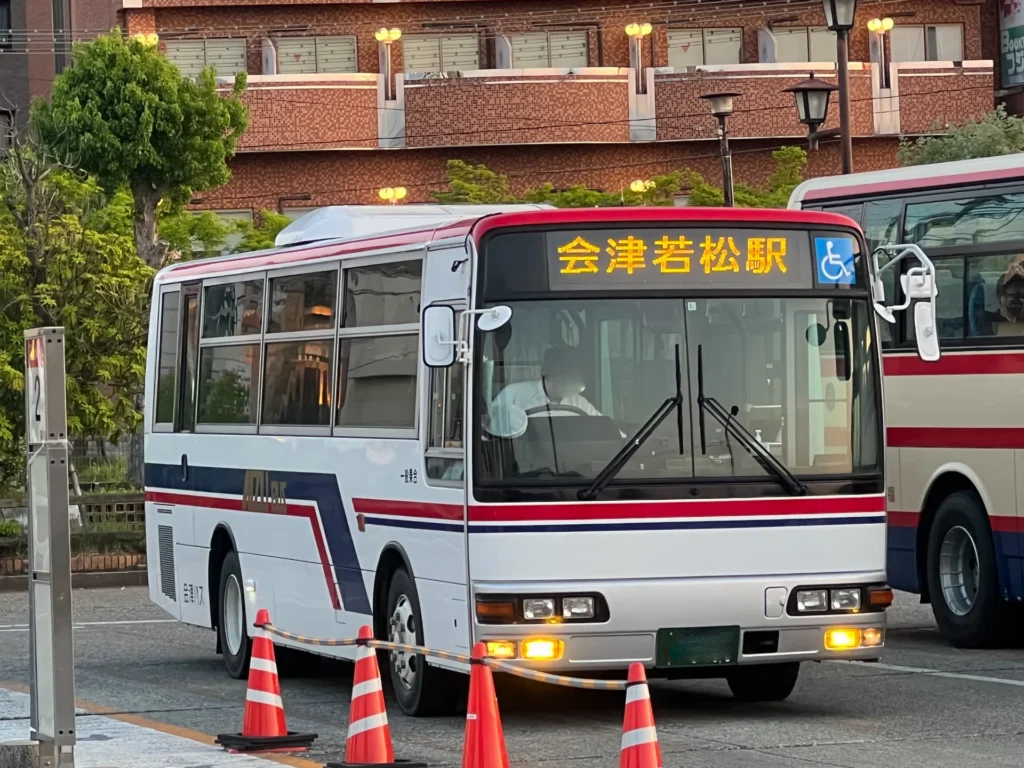
In order to enjoy Fukushima without a car, it is important to make good use of public transport. Within Fukushima Prefecture, there are convenient trains and buses in place, and access to tourist spots is good. Here, we will introduce in detail the means of transportation that will allow you to enjoy your visit to Fukushima smoothly.
First of all, it is most efficient to use Fukushima Station as your base. From Fukushima Station, you can use the Tohoku Shinkansen or local trains, and it is easy to access major tourist destinations. For example, you can travel comfortably to Aizu Wakamatsu or Urabandai by train. In particular, the train to Aizu Wakamatsu allows you to enjoy the scenic views as you travel, so you can get excited from the start of your trip.
Next, we also recommend using the bus. There is a good network of bus routes connecting Fukushima City and the surrounding area, and there are also many direct buses to tourist spots. In particular, the dedicated sightseeing buses to Hanamiyama Park and Goshikinuma are convenient. If you check the bus timetable in advance, you can move around smoothly. Also, one of the attractions is that you can enjoy the beautiful nature of Fukushima from the bus window.
In addition, using a taxi is also an option. Taxis are particularly convenient for moving between tourist spots or when you don’t have much time to spare. There are many taxi companies in Fukushima City, and you can easily call one using a smartphone app. If you request a sightseeing spot from the driver, they may be able to recommend a spot that is unique to the local area.
In this way, in Fukushima, you can enjoy a fulfilling sightseeing experience even without a car by skillfully combining trains, buses and taxis. By using public transport, you can enjoy the beautiful scenery of Fukushima while traveling, and make your trip stress-free.
Day 1: Tour of the Fukushima Station area and scenic spots
The first day of your Fukushima sightseeing tour starts in the Fukushima Station area. First, visit Fukushima Inari Shrine, which is within walking distance of the station. The beautiful torii gates lining the precincts create a tranquil atmosphere that will calm your heart. Next, visit the Koseki Yuji Memorial Hall and trace the footsteps of the Fukushima-born composer, while listening to some of his famous works.
After that, you will head to Hanamiyama Park using public transport. This park, where you can enjoy cherry blossoms in spring and autumn leaves in autumn, is attractive for its beauty in each of the four seasons. Let’s enjoy the beauty of nature while taking a walk.
Next, you will go on a hike to the Goshikinuma lakes in the Urabandai area. The mysterious colors of the lakes are a popular photo spot that attracts visitors. After refreshing yourself in nature, we recommend enjoying lunch with Kitakata ramen. Try the delicious ramen at local restaurants such as Sakanai Shokudo and Yamakoto Shokudo.
To finish off the first day, choose where you want to stay. You could spend a relaxing time at a hot spring ryokan, or you could stay at a hotel in Fukushima City for a comfortable night’s sleep. After a full day, get ready for tomorrow’s sightseeing.
Tourist Spots around Fukushima Station|Fukushima Inari Shrine / Koseki Yuji Memorial Hall

There are many tourist spots around Fukushima Station, so you can enjoy them even without a car. The first place you should visit is Fukushima Inari Shrine. This shrine is about a 15-minute walk from the station and is a popular spot with the locals. There are beautiful torii lined up in the precincts, and the red torii in particular are very impressive. While praying, you can calm your heart in the quiet atmosphere. Also, you can enjoy the nature of each season around the shrine, so you can enjoy different scenery depending on the time of year you visit.
Next, we recommend a visit to the Koseki Yuji Memorial Hall. This memorial hall, which introduces the achievements of Koseki Yuji, a composer from Fukushima City, is located about 20 minutes on foot from Fukushima Station. The hall has displays of his major works and life story, and is enjoyable not only for music fans but also for those interested in history and culture. In particular, the displays with his music playing are moving for visitors.
By taking a stroll around Fukushima Station, you can not only get in touch with the local culture and history, but also efficiently tour the area as the tourist spots are close together. In between sightseeing, you can enjoy the local cuisine at the cafes and restaurants in the area. This area, where you can fully experience the charm of Fukushima, is the perfect starting point for a 2-day, 1-night trip.
Visiting at night is recommeded!
Strolling through Hanamiyama Park (cherry blossoms in spring, autumn leaves in autumn)

Hanamiyama Park in Fukushima Prefecture is a popular spot for tourists to enjoy the beautiful scenery of each season. In spring, in particular, the park is filled with around 1,000 cherry trees in full bloom, attracting visitors. As you stroll through the park and walk through the tunnel of cherry blossoms, you will feel as if you are in a dream. The best time to see the cherry blossoms is usually from the beginning to the middle of April, but this can vary depending on the weather, so we recommend checking the information beforehand.
In autumn, Hanamiyama Park is also known as a popular spot for viewing the changing colors of the leaves. The mountains are colored with a variety of autumnal hues, and the reds of the maple and Japanese maple trees are particularly vivid. You can enjoy the beauty of nature as you walk along the park’s walking paths. It is also a special experience to spend a relaxing time while feeling the arrival of autumn.
Hanamiyama Park is easily accessible by bus from Fukushima Station, making it a great place to visit using public transport. After getting off the bus, you can reach the park with a short walk, so you can drop in at any time. The park is also fully equipped with rest areas and toilets, so you can enjoy your stroll in peace of mind.
In addition, there are also shops and cafes selling local specialties dotted around the area around Hanamiyama Park, so you can enjoy delicious sweets and light meals in between your walks. In particular, there are also shops where you can try Fukushima specialties such as “ichigo daifuku” (strawberry mochi) and “Kitakata ramen”, so be sure to drop by.
As you can see, Hanamiyama Park is a spot where you can not only enjoy the cherry blossoms in spring and the autumn leaves in autumn, but also the local food and culture. Why not visit when you are sightseeing in Fukushima? You can experience the beauty of nature and the charm of the local area at the same time.
It’s about 20-minutes by car from Fukushima Station.
Mystical Scenery: Hiking the Goshikinuma Lakes (Urabandai Area)

The Goshikinuma Lakes are a spot in the Urabandai area of Fukushima Prefecture that offers beautiful natural scenery. The lakes were named “Goshikinuma” (five-colored lakes) because their surface water takes on different hues depending on the season and weather. On sunny days in particular, the lakes take on a variety of colors, such as emerald green, cobalt blue, and deep indigo, and this is what attracts visitors to the area.
The hiking trails are well maintained, and routes are available for everyone from beginners to advanced hikers. We particularly recommend the 2-hour course that takes you all the way around the Five-Colored Lakes. Along the way, you can enjoy the view from the observation deck overlooking the lakes and trails through the quiet forest, and you can refresh yourself in nature. Also, because you can enjoy the scenery of each season, many tourists visit during the spring when the new green leaves come out and in the autumn when the leaves change color.
While hiking, you may also have the chance to see wild animals and a variety of plants. In spring, the area is full of colorful flowers, and in autumn, the beautiful scene of the autumn leaves reflected on the surface of the lake spreads out. The beauty of nature here will surely be an unforgettable memory for visitors.
In addition, there are also many tourist facilities and rest areas around the Goshikinuma lakes. After hiking, you can enjoy a light meal made with local ingredients at a nearby cafe. In particular, the fresh vegetables from Urabandai and the local specialities will surely help you to recover from the fatigue of your sightseeing.
The Goshikinuma Lakes are a spot that is well worth visiting when sightseeing in Fukushima. Why not enjoy a refreshing hike while enjoying the beauty of nature?
It takes about 1hour half one way!
Delicious Gourmet! Lunch at Kitakata Ramen restaurants (Sakanai Shokudo, Makoto Shokudo, etc.)
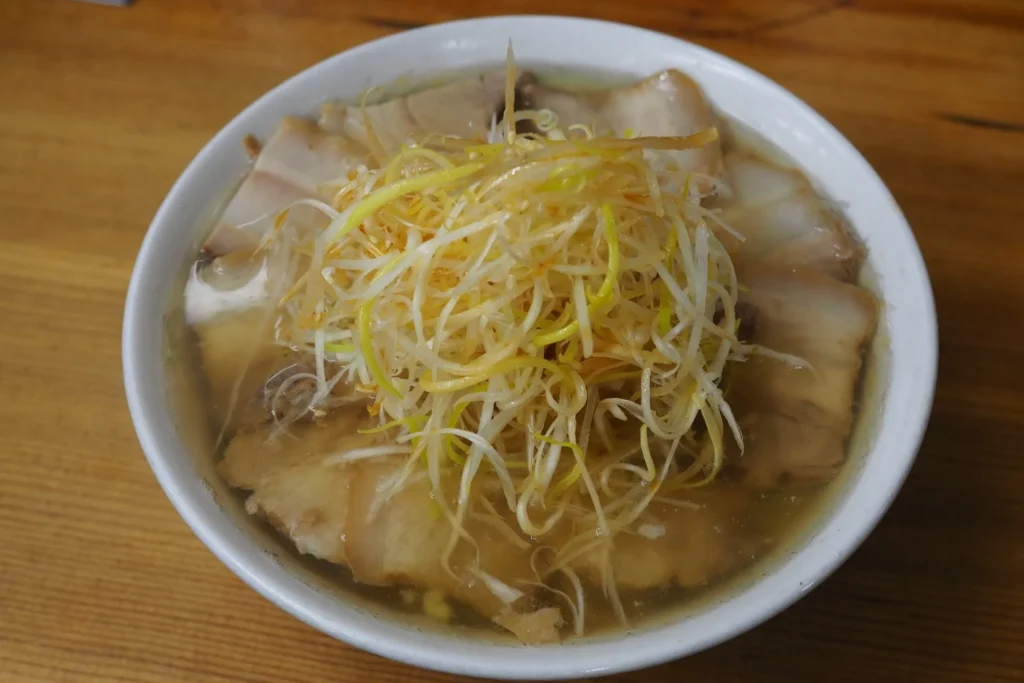
One of the joys of sightseeing in Fukushima is the delicious local cuisine. In particular, Kitakata ramen is known as a specialty dish that represents Fukushima Prefecture. Kitakata City is known as the holy land of ramen, and there are many ramen restaurants lining the streets. Here, we will introduce some of the ramen restaurants that we particularly recommend.
First, there is “Sakanai Shokudo”. This is a particularly famous restaurant in the Kitakata ramen scene, and it is also a favorite of the locals. The soup is a simple soy sauce-based broth, and it is characterized by its richness and easy-drinking nature. The homemade medium-thick noodles have a chewy texture that goes perfectly with the soup. The toppings are piled high with chashu pork, pickled bamboo shoots and spring onions, and the bowl is a feast for the eyes as well as the stomach.
Next up is Makoto Shokudo. This is another popular ramen restaurant, and the ‘special ramen’ is particularly recommended. The soup is rich and full-bodied, with a deep flavor that comes from slow-cooked pork and chicken bones. The toppings include tender slices of roast pork, a boiled egg and plenty of bean sprouts, making it a very filling bowl of ramen. It’s the perfect choice for those looking for a filling bowl of ramen.
One of the appeals of Kitakata ramen is its diversity. Each restaurant has its own unique soup, noodles and toppings, so it’s a good idea to enjoy comparing them. Be sure to try some local ramen while you’re sightseeing. After exploring the beautiful nature and history of Fukushima, a bowl of Kitakata ramen will be the perfect reward for your efforts.
Also, there are many ramen restaurants scattered around the city of Kitakata, so be sure to drop in when you’re sightseeing. Each restaurant has its own unique character, and is a must-visit for ramen lovers. Even if you don’t have a car, you can still get there using public transport, so you can visit with peace of mind. When enjoying your sightseeing in Fukushima, don’t forget to try the superb Kitakata ramen!
Annual ramen festivals are also held.
Day 2: A trip to Fukushima to enjoy the hot springs, history and culture
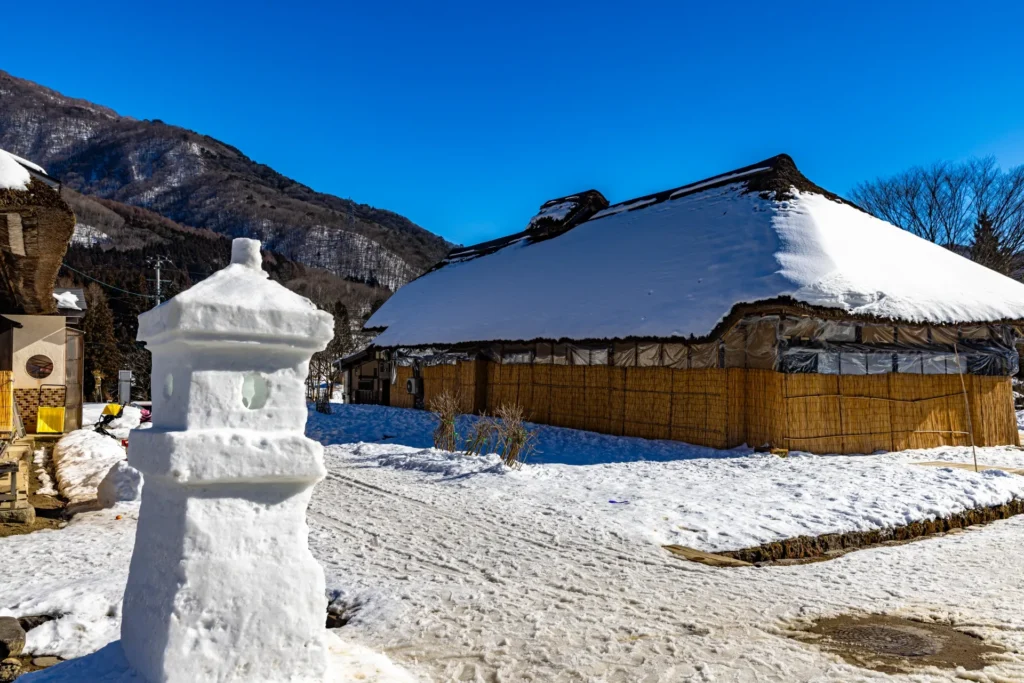
On the second day of your trip to Fukushima, you can enjoy the hot springs, history and culture to your heart’s content. First, head to Ouchi-juku, which is perfect for a morning stroll. Ouchi-juku, which is known as a post town from the Edo period, is lined with houses with thatched roofs, and you can enjoy the atmosphere as if you had stepped back in time. Here, we also recommend “negi soba”, which allows you to experience traditional food culture. The style of eating using the leeks as chopsticks is also popular with tourists.
Next, we will visit Higashiyama Onsen, which is one of Japan’s three great hot-spring resorts. There are also many ryokan (Japanese-style inns) where you can enjoy a day trip bathing in the hot spring and enjoying the beautiful nature. In particular, the view from the open-air bath is exceptional, and you can be sure that you will be refreshed both mentally and physically.
After that, move on to Aizu Wakamatsu and visit Tsurugajo Castle. Tsurugajo Castle is an important spot where you can feel the history of the Aizu clan, and the view from the castle tower is also wonderful. Inside the castle, you can learn about the history of Aizu through historical exhibits and materials.
Finally, let’s finish off with some of Fukushima’s famous gourmet food. The Aizu specialty of sauce katsudon is very filling and delicious. At the famous restaurants “Nakajima” and “Hakukujishokudo”, you can enjoy the taste that is loved by the locals. After being healed by the hot spring, let’s make your trip to Fukushima a memorable one by enjoying the delicious gourmet food.
Perfect for a morning stroll|The thatched-roof townscape of Ouchi-juku (an Edo-era post town)
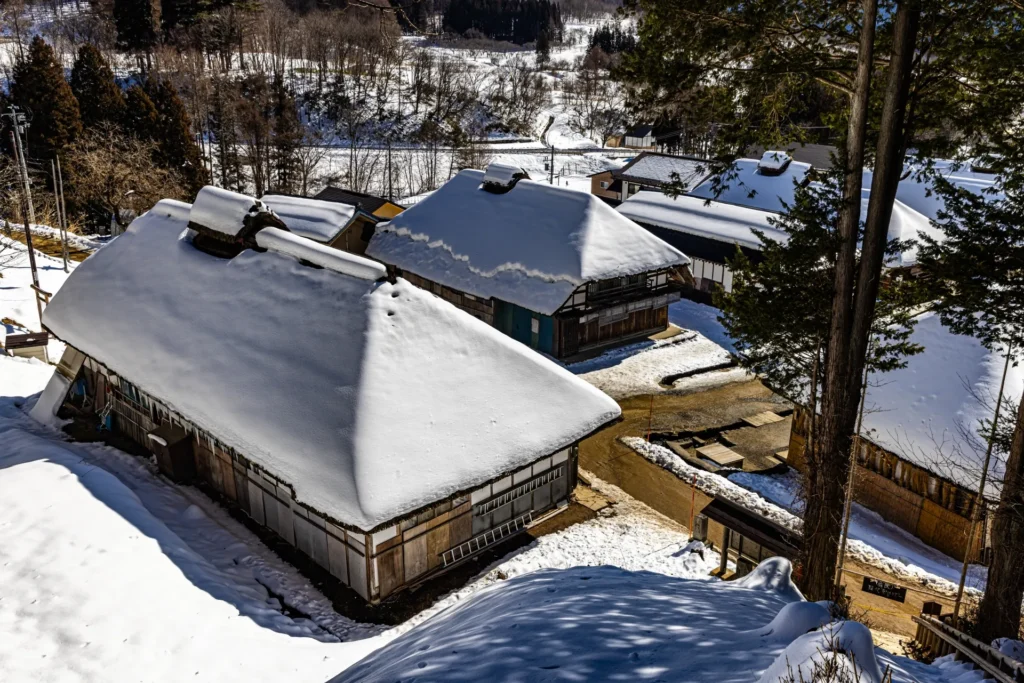
Ouchi-juku in Fukushima Prefecture is a beautiful place that still retains many traces of its history as a post town from the Edo period. Here, you can enjoy the feeling of stepping back in time as you walk along the rows of houses with thatched roofs. The morning hours are particularly good for taking a leisurely stroll through the town in the quiet. As the sun rises, the thatched roofs become even more beautiful, providing a sense of peace to visitors.
Ouchi-juku prospered as an important post town linking Aizu and Shimotsuke in the past. Even today, many buildings and scenery that give a sense of its history remain, making it a valuable experience for tourists. In particular, the thatched-roof houses show the traditional architectural style of the region, and convey their charm to visitors.
While strolling around, don’t forget to try the local specialty, “negi soba” (noodles with leeks). The style of eating using the leeks as chopsticks is a unique way to enjoy the local delicacy. Enjoying the local flavors in the fresh morning air is one of the true pleasures of traveling.
In addition, Ouchi-juku offers a different landscape in each season. In spring, the cherry blossoms bloom in full glory, and in summer, the lush green nature spreads out. In autumn, the changing leaves are beautiful, and in winter, the snowy landscape creates a magical atmosphere. You can feel the charm of the area no matter what time of year you visit.
Ouchi-juku is a spot that is particularly worth visiting as part of your sightseeing in Fukushima. It is possible to access the area without a car, and it is easy to get there using public transport. If you take a bus from Fukushima Station, you will arrive in about an hour, so why not enjoy a morning stroll? Spend a memorable time in Ouchi-juku, where history and nature come together.
Visiting at night is recommended!
One of Japan’s three great hot-spring resorts! Day trip bathing at Higashiyama Onsen
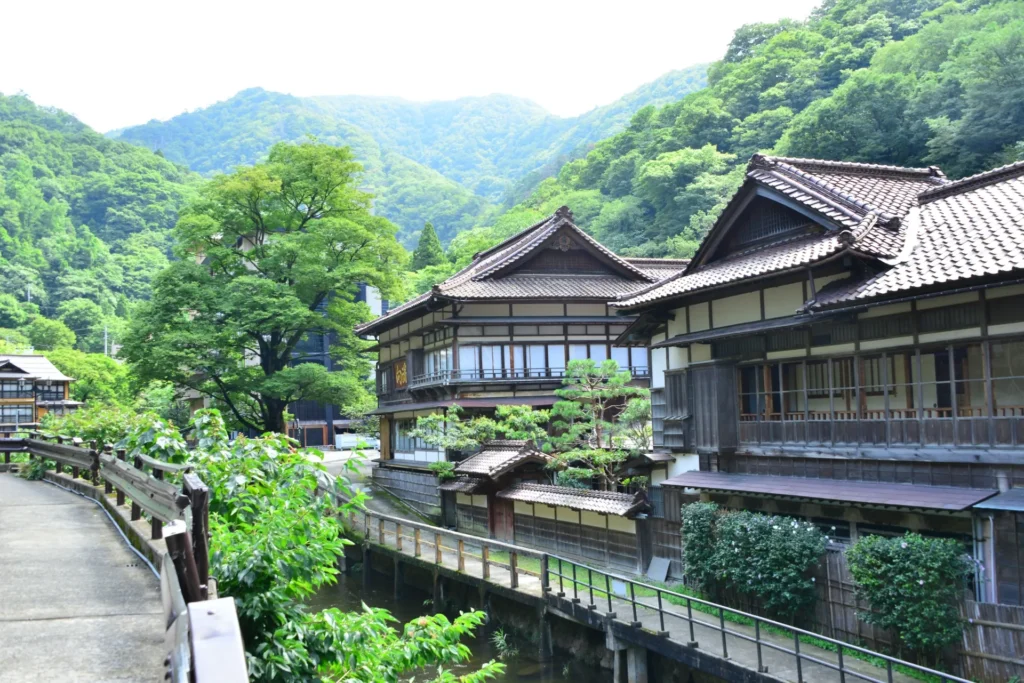
Fukushima Prefecture is home to Higashiyama Onsen, one of Japan’s three most famous hot-spring resorts. Located near Aizu Wakamatsu City, this hot-spring resort, surrounded by abundant nature, is lined with historic hot-spring inns that attract visitors. The appeal of Higashiyama Onsen is its beautiful scenery and the high quality of its hot spring water, which soothes the body and mind.
There are also many inns where you can take a day trip and enjoy a hot spring bath, so you can drop in casually between sightseeing. In particular, the hot spring water from the source is gentle on the skin and has a great relaxing effect. Looking at the surrounding nature while soaking in the hot spring will make you forget all your daily worries in an instant. In addition, you can enjoy the scenery of the four seasons in Higashiyama Onsen, so you can experience a different charm depending on the time of year you visit.
The hot spring resort town also has a wide range of restaurants serving local cuisine, so you can enjoy a delicious meal after your hot spring bath. In particular, the Aizu specialty dishes of “sauce pork cutlet rice bowl” and “horse sashimi” are dishes you definitely want to try.
Higashiyama Onsen also has good access to tourist attractions, so it is easy to visit historical spots such as Tsurugajo Castle in Aizu Wakamatsu and Ouchi-juku. After refreshing yourself in the hot spring, we recommend visiting the surrounding tourist attractions. To enjoy the nature and culture of Fukushima to the fullest, please plan a visit to Higashiyama Onsen.
It’s about 15-minute from Aizuwakamatsu station!
Finish off with a sauce katsudon! Enjoy the famous Aizu gourmet food (famous restaurants: Nakajima, Hakukujishokudo)

The final dish of your trip to Fukushima will be the Aizu specialty, sauce katsudon. The juicy pork cutlet, wrapped in a crispy batter, is mixed with the special sauce, whetting your appetite. In the Aizu region, sauce katsudon is generally served with the cutlet on top of the rice, and then a generous amount of sauce is poured on top. It is very filling and extremely satisfying.
Two particularly recommended restaurants are Nakajima and Hakukujishokudo. Nakajima is a long-established restaurant that is also popular with the locals, and is known for the perfect balance between the thickness of the cutlet and the sauce. The highlight here is that they serve the cutlet freshly fried so that you can enjoy the crispiness of the cutlet. It is also very filling.
On the other hand, Hakukujishokudo is a popular spot for tourists, and its homely atmosphere is its charm. The sauce used in the pork cutlet rice bowl at this restaurant is made from a special sauce that has been thoroughly absorbed into the pork cutlet, giving it a rich flavor. Both restaurants use local ingredients, so you can enjoy your meal with peace of mind.
After enjoying the pork cutlet rice bowl, why not try some dessert too? We recommend the Aizu no Kozuyu, a specialty of the Aizu region, or sweets made with local fruit. In particular, the fruit parfaits, which change with the seasons, are beautiful to look at and are perfect for ending your trip on a high note.
One of the real joys of traveling is being able to enjoy delicious local cuisine. As you enjoy your sauce katsudon, you will look back on your trip and look forward to your next visit. After you have fully enjoyed the charms of Fukushima, you will definitely want to return again in search of new discoveries.
It’s about 15-minute by car from Aizuwakamatsu station!
Tips for enjoying your visit to Fukushima even more
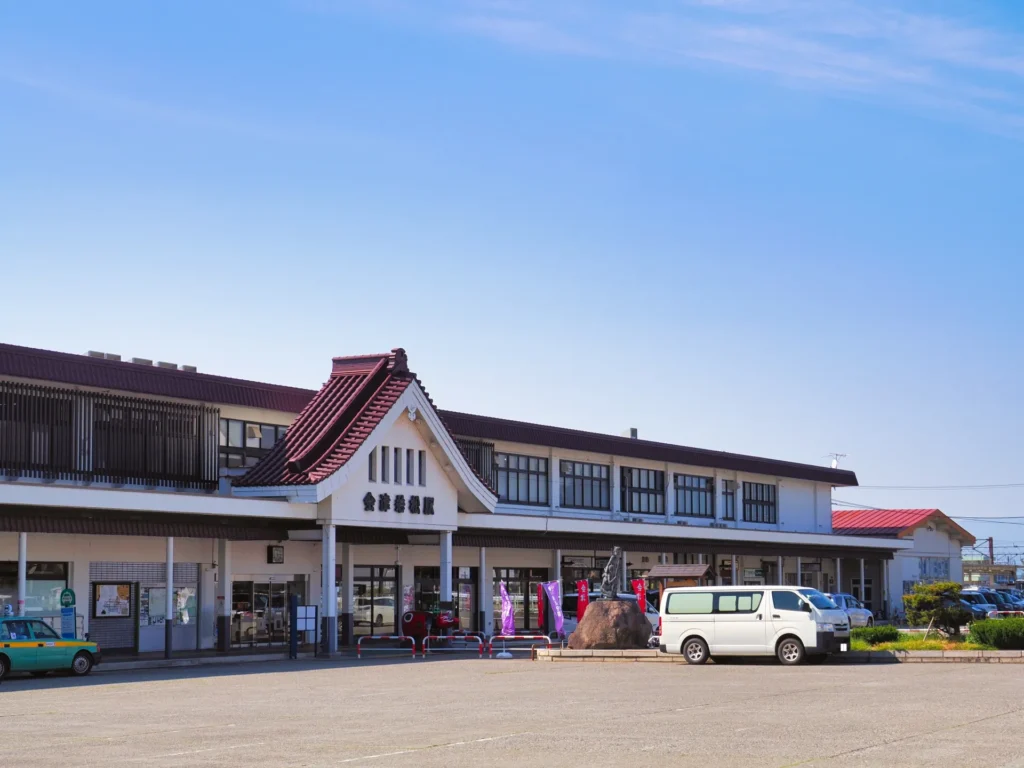
If you keep the following points in mind when visiting Fukushima, you will be able to make the most of your sightseeing experience. First of all, we recommend that you use the JR East Free Pass when using public transport. This pass will make it easier to access major tourist destinations in Fukushima Prefecture and will help you to keep your travel costs down. The pass is particularly useful in areas where there are many trains and buses running.
Next, checking tourist apps and websites before your trip will give you the latest information. For example, checking opening hours, event information and crowding levels of tourist spots in advance will make it easier to plan your trip. You can also use apps to find information on local gourmet food and recommended restaurants, so you will have a wider choice of places to eat.
Furthermore, the tourist attractions in Fukushima can be enjoyed in all four seasons, so you can experience the different charms of the area depending on the time of year you visit. In spring, the cherry blossoms at Hanamiyama Park are a highlight, and in autumn the changing leaves are a highlight. By making use of this information and planning your visit to suit the time of year, you can be sure to get even more satisfaction out of your trip.
Finally, it is also important to enjoy interacting with the local people at tourist attractions. By asking the locals for their recommendations and hidden gems, you may be able to discover even more of the charms of Fukushima. Please make the most of your visit to Fukushima by referring to these points.
Convenient Transportation Passes for Sightseeing|Making the Most of JR East’s Free Passes
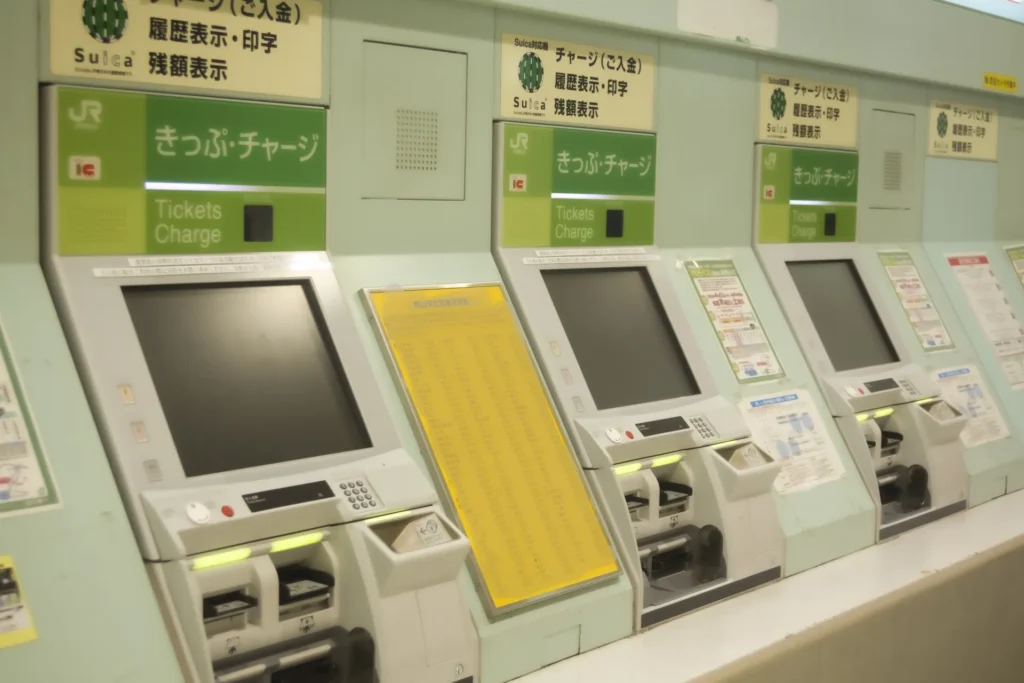
In order to enjoy Fukushima without a car, it is important to make good use of public transport. One of the most convenient options is JR East’s free passes. Using these passes, you can not only access the main tourist spots in Fukushima Prefecture smoothly, but also travel economically.
There are various types of JR East free passes, but the “East Japan Pass” and “Fukushima/Niigata Pass” are particularly suitable for sightseeing. Using these passes, you can easily travel to popular spots such as Aizu Wakamatsu, Urabandai and Kitakata, all starting from Fukushima Station. For example, it takes about 1.5 hours to get from Fukushima Station to Aizu Wakamatsu by express train. Not only does this save you the trouble of driving, but you can also enjoy the scenery as you travel.
In addition, by using a free pass, you can ride as many buses and local trains as you like, so it’s easy to get around between tourist spots. For example, there is a direct bus from Fukushima Station to Goshikinuma in the Urabandai area, so you can enjoy the beauty of nature as you travel. Furthermore, you can also use the free pass on buses around tourist spots, so you can efficiently visit tourist spots.
When purchasing a free pass, it’s a good idea to check the routes you plan to use in advance. Especially during the tourist season, it is important to make early reservations and plans, as congestion is expected. Also, by making sure you know the validity period of the pass and the routes you can use, you can enjoy your sightseeing without wasting time.
In this way, by making use of JR East’s free passes, you can enjoy the charms of Fukushima to the full while also making your trip comfortable even without a car. In the next section, we will introduce specific tourist spots and means of transport in detail, so please look forward to it!
Check before you travel! Recommended sightseeing apps and websites

When visiting Fukushima, you can enjoy a smoother and more fulfilling trip by making use of useful sightseeing apps and websites in advance. Here, we will introduce some particularly recommended apps and websites.
First of all, you should definitely check out the “Fukushima Prefecture Tourism Information Site”, which has comprehensive tourist information. This site has a wealth of information on tourist spots, events and gourmet food in Fukushima. In particular, it is useful for planning a trip according to the time of year you are visiting, as it has seasonal recommendations and features on each region.
Next, Google Maps is very useful for planning your travel. You can use it to search for public transport timetables and routes, which is handy when using trains and buses. You can also check reviews of restaurants and tourist spots in the area, which is useful for finding places you want to visit.
In addition, you should also make use of gourmet information sites such as Tabelog and Gurunavi. There are many delicious restaurants in Fukushima, but by checking reviews and ratings in advance, you can choose a restaurant that won’t let you down. In particular, when enjoying local specialties such as Kitakata ramen or sauce katsudon, it is important to find a restaurant that is popular with the locals.
We also recommend official apps for tourist destinations. For example, the Aizu Wakamatsu City sightseeing app contains detailed information on historical spots such as Tsurugajo Castle and Ouchijuku, and also has a voice guide function. This allows you to enjoy sightseeing while feeling the history more deeply.
Finally, social networking services can also be useful for gathering information. By searching for hashtags such as “#Fukushima tourism” or “#Fukushima gourmet” on Instagram or Twitter, you can find out about the real experiences of other travelers and recommended spots. This is particularly useful for finding the latest information and hidden gems.
By making use of these apps and sites, you can bring out the best of Fukushima and make your trip a wonderful experience. Advance preparation is the key to a more enjoyable trip.
Summary|A 2-day, 1-night trip to Fukushima that you can enjoy even without a car
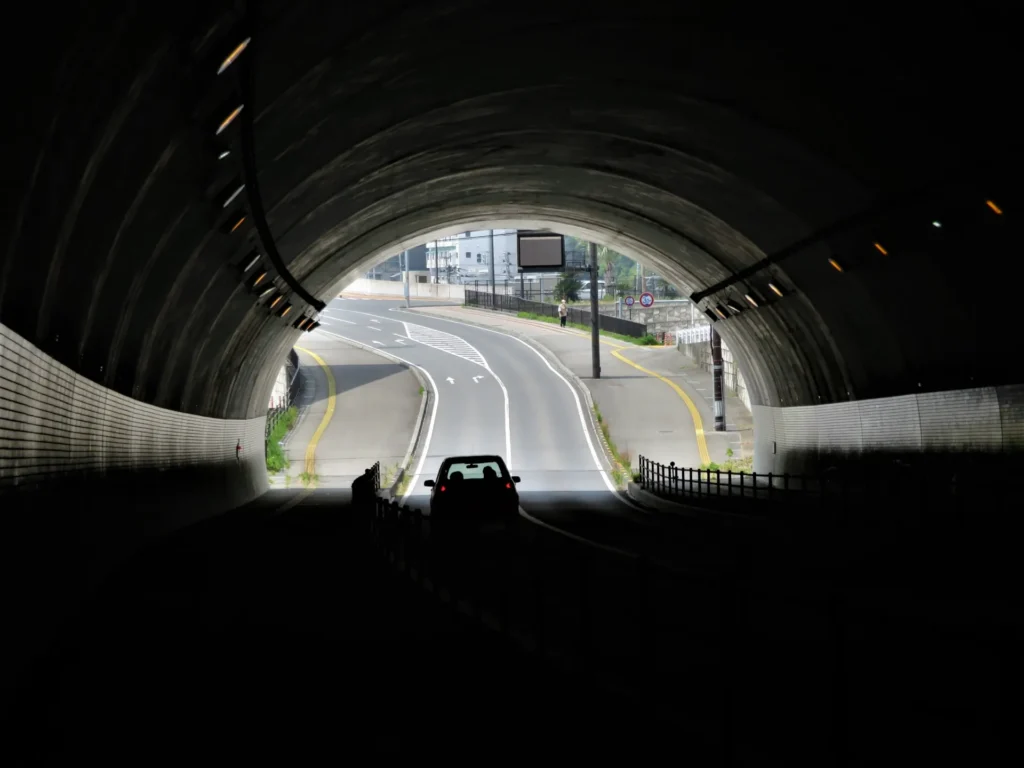
Fukushima Prefecture is full of tourist attractions that you can enjoy even without a car. Through this 2-day, 1-night model course, you can get a real taste of the charms of Fukushima. By starting from Fukushima Station and visiting spots that can be accessed using public transport, you can enjoy sightseeing in an efficient way.
On the first day, we visited tourist spots around Fukushima Station, and after getting a taste of the history and culture at Fukushima Inari Shrine and the Koseki Yuji Memorial Hall, we enjoyed the natural beauty of Hanamiyama Park, which boasts seasonal beauty. Next, we went hiking in the Goshikinuma lakes and swamps in the Urabandai area, and were captivated by the mysterious scenery. We also enjoyed the gourmet food of Fukushima by having Kitakata ramen for lunch. By choosing to stay at a hot spring ryokan or a hotel in Fukushima City, we were able to relax and recover from the fatigue of our travels.
On the second day, we strolled through the thatched-roof houses of Ouchi-juku and felt the atmosphere of the Edo period. After enjoying a day trip to the Higashiyama Onsen hot spring, one of Japan’s three great hot springs, we visited Tsurugajo Castle in Aizu Wakamatsu and had a valuable experience learning about history. Finally, we enjoyed a delicious meal of Aizu’s famous sauce katsudon, a dish that was a fitting end to our trip.
As you can see, Fukushima has a wide variety of tourist attractions and delicious food even without a car, and you can enjoy your trip without stress by using public transport. When planning your trip, it is important to think about an efficient route and check the opening hours and access methods of tourist attractions in advance. Please experience the charm of Fukushima to the fullest and have a wonderful trip that will stay in your heart.
Review of recommended routes|Tips for making the most of your trip

In order to enjoy Fukushima without a car, it is important to plan an efficient route. In this 2-day, 1-night model course, you can use public transport to visit the main tourist spots, starting from Fukushima Station. On the first day, after visiting the tourist spots around Fukushima Station, you can go to Hanamiyama Park and Goshikinuma. These spots are easily accessible from the station, and you can get around smoothly by bus or taxi.
Specifically, it takes about 15 minutes to walk from Fukushima Station to Fukushima Inari Shrine, and the same distance to the Koseki Yuji Memorial Hall. After enjoying the sights, take a bus to Hanamiyama Park and enjoy the beautiful scenery of each season. In particular, you won’t want to miss the cherry blossoms in spring or the autumn leaves. Next, you can take a bus to Urabandai to enjoy hiking in the Goshikinuma lakes and marshes. The appeal is that you can enjoy the spectacular scenery while refreshing yourself in nature.
For lunch, be sure to try some Kitakata ramen. There are many famous local restaurants, such as Sakanai Shokudo and Yamakoto Shokudo, and it’s easy to get around by bus. After lunch, head to your accommodation and relax in the hot spring to soothe away your fatigue. Hotels and hot spring ryokan in Fukushima City have good access to tourist spots, so you can expect a comfortable stay.
On the second day, we recommend visiting Ouchi-juku. Strolling through the thatched-roof houses while feeling the atmosphere of a post town from the Edo period is a unique experience that can only be enjoyed in Fukushima. From here, you can head to Higashiyama Onsen and enjoy a day trip bathing. Finally, visit Tsurugajo Castle in Aizu Wakamatsu and spend some time feeling the history. Don’t forget to enjoy Aizu’s famous sauce katsudon to finish off your trip.
In order to efficiently tour the tourist spots of Fukushima, it is important to plan your route in advance and check the timetables for public transport. By planning a schedule that allows for enough time to travel between tourist spots, you will be able to enjoy a more fulfilling trip.
What to bring and points to note for a comfortable trip
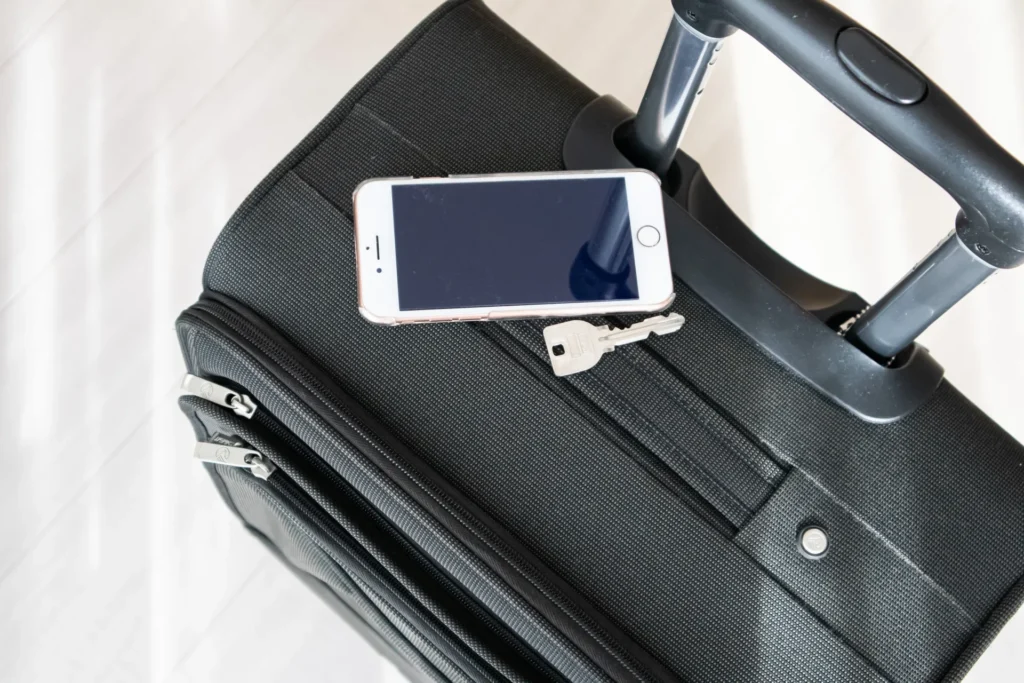
In order to enjoy Fukushima without a car, advance preparation is important. In order to make your trip comfortable, be sure to check what to bring and what points to note.
First of all, lightweight backpacks and tote bags are convenient to have with you. When touring tourist spots, you can carry the things you need in a compact package, making it easier to move around. It is also important to choose clothes that are appropriate for the season. In spring and autumn, the temperature can change dramatically, so make sure you have clothes that you can layer up or down with, so you can respond to sudden changes in the weather.
Next, we recommend bringing a mobile battery as a useful item when sightseeing. As you will often be using your smartphone to check maps and sightseeing information, a battery charger is essential to prevent your battery from running out. Also, if you are using public transport, having a transport IC card ready in advance will make your journey smoother.
As a point to note, some tourist spots get busy at certain times of day, so it is important to plan your visit in advance. In particular, we recommend visiting popular spots and restaurants early to avoid the crowds. Also, checking the operating hours and frequency of public transport can help reduce the stress of traveling.
Furthermore, there are many opportunities to enjoy nature at tourist spots in Fukushima. When hiking or walking, it is important to choose shoes that are easy to walk in. In particular, at natural spots such as Goshikinuma and Hanamiyama Park, there are places where the footing is unstable, so be sure to wear sturdy shoes when you go out.
Finally, in order to enjoy the charms of Fukushima to the full, it is also important to interact with the local people. By talking to the people you meet at tourist spots, you may be able to find out about hidden places of interest or recommended restaurants. Please enjoy communicating with people actively in order to make your trip even more memorable.
Please enjoy your trip to Fukushima, making the most of the things you can do and the points to remember. Even without a car, you can still have a great time!
We will introduce a model course for sightseeing in Fukushima that you can enjoy without a car, taking in the beautiful scenery of Hanamiyama Park and Goshikinuma, historical spots in Aizu Wakamatsu, and delicious local cuisine. We will explain in detail about efficient means of transportation and recommended routes, so please use this as a reference for your trip!
Fukushima can be enjoyed without a car! A 2-day, 1-night model course

Fukushima Prefecture is a tourist destination packed with natural beauty and historical charm. Even without a car, you can still enjoy it to the full over a 2-day, 1-night stay by using public transport. Starting from Fukushima Station, you can make good use of trains and buses to efficiently tour the tourist spots. In particular, there are many places of interest in the Fukushima City, Aizu Wakamatsu and Urabandai areas.
Fukushima’s appeal lies in its beautiful scenery that changes with the seasons, its historic sites, and its delicious local cuisine. In spring, you can enjoy the cherry blossoms at Hanamiyama Park, and in autumn you can enjoy the changing leaves, and the area shows a different face in each season. There are also many spots where you can feel the history of the area, such as Tsurugajo Castle in Aizu Wakamatsu and Ouchi-juku, and there are also plenty of cultural experiences to enjoy.
In addition, you shouldn’t miss the hot spring resorts in Fukushima. There are many hot spring ryokans where you can take a day trip and relax, perfect for relieving the fatigue of your travels. If you use public transport, you can move around smoothly and enjoy sightseeing to the full. Please refer to the model course we will introduce from now on and experience the charm of Fukushima.
The charm of Fukushima sightseeing|Why you can enjoy it even without a car

Fukushima Prefecture is a tourist destination packed with natural beauty and historical charm. Even without a car, you can still enjoy the full appeal of the area by using public transport. First, by making Fukushima Station your starting point, you can easily access the surrounding tourist spots. Buses and trains run frequently from the station, making it easy to get around to the tourist spots.
Furthermore, another of the attractions of Fukushima’s tourist spots is that many of them are in areas that are easy to get around on foot or by bicycle, even if you are using public transport. For example, within walking distance of Fukushima Station are tourist spots such as Fukushima Inari Shrine and the Koseki Yuji Memorial Hall. This means that you can get a feel for the local atmosphere while touring the tourist spots.
In addition, Fukushima Prefecture is home to beautiful natural scenery that changes with the seasons. In particular, Hanamiyama Park and Goshikinuma are easily accessible by public transport, and you can enjoy the spectacular views. These spots are worth visiting even if you don’t have a car, and they are particularly popular with tourists in spring when the cherry blossoms are in bloom and in autumn when the leaves are changing color.
Furthermore, Fukushima’s appeal is not limited to its tourist attractions. You should also not miss out on the local cuisine. You can enjoy delicious dishes unique to Fukushima, such as Kitakata ramen and sauce katsudon. Many of these restaurants are also located in places that are easily accessible by public transport.
As you can see, Fukushima Prefecture is a tourist destination that can be enjoyed even without a car. By using public transport, you can efficiently tour the tourist spots while also enjoying the local culture and nature. In the next section, we will introduce specific means of transport and recommended routes in detail, so please refer to them.
Fukushima by Public Transport|Recommended Means of Transportation (How to Use Trains, Buses and Taxis)

In order to enjoy Fukushima without a car, it is important to make good use of public transport. Within Fukushima Prefecture, there are convenient trains and buses in place, and access to tourist spots is good. Here, we will introduce in detail the means of transportation that will allow you to enjoy your visit to Fukushima smoothly.
First of all, it is most efficient to use Fukushima Station as your base. From Fukushima Station, you can use the Tohoku Shinkansen or local trains, and it is easy to access major tourist destinations. For example, you can travel comfortably to Aizu Wakamatsu or Urabandai by train. In particular, the train to Aizu Wakamatsu allows you to enjoy the scenic views as you travel, so you can get excited from the start of your trip.
Next, we also recommend using the bus. There is a good network of bus routes connecting Fukushima City and the surrounding area, and there are also many direct buses to tourist spots. In particular, the dedicated sightseeing buses to Hanamiyama Park and Goshikinuma are convenient. If you check the bus timetable in advance, you can move around smoothly. Also, one of the attractions is that you can enjoy the beautiful nature of Fukushima from the bus window.
In addition, using a taxi is also an option. Taxis are particularly convenient for moving between tourist spots or when you don’t have much time to spare. There are many taxi companies in Fukushima City, and you can easily call one using a smartphone app. If you request a sightseeing spot from the driver, they may be able to recommend a spot that is unique to the local area.
In this way, in Fukushima, you can enjoy a fulfilling sightseeing experience even without a car by skillfully combining trains, buses and taxis. By using public transport, you can enjoy the beautiful scenery of Fukushima while traveling, and make your trip stress-free.
Day 1: Tour of the Fukushima Station area and scenic spots
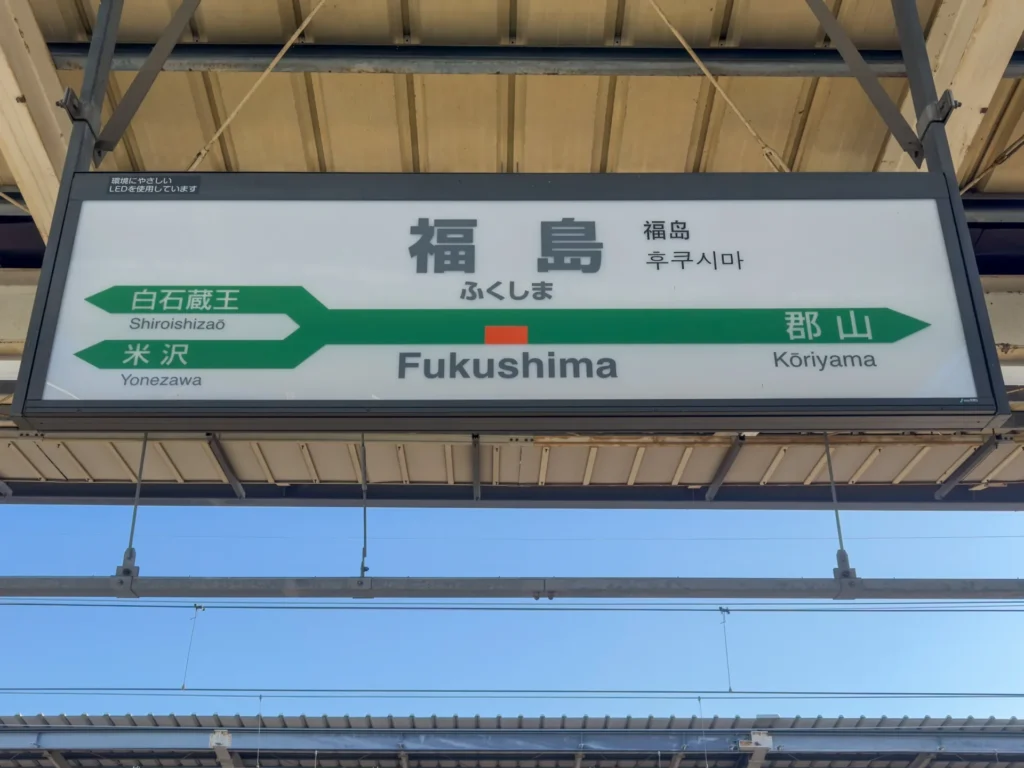
The first day of your Fukushima sightseeing tour starts in the Fukushima Station area. First, visit Fukushima Inari Shrine, which is within walking distance of the station. The beautiful torii gates lining the precincts create a tranquil atmosphere that will calm your heart. Next, visit the Koseki Yuji Memorial Hall and trace the footsteps of the Fukushima-born composer, while listening to some of his famous works.
After that, you will head to Hanamiyama Park using public transport. This park, where you can enjoy cherry blossoms in spring and autumn leaves in autumn, is attractive for its beauty in each of the four seasons. Let’s enjoy the beauty of nature while taking a walk.
Next, you will go on a hike to the Goshikinuma lakes in the Urabandai area. The mysterious colors of the lakes are a popular photo spot that attracts visitors. After refreshing yourself in nature, we recommend enjoying lunch with Kitakata ramen. Try the delicious ramen at local restaurants such as Sakanai Shokudo and Yamakoto Shokudo.
To finish off the first day, choose where you want to stay. You could spend a relaxing time at a hot spring ryokan, or you could stay at a hotel in Fukushima City for a comfortable night’s sleep. After a full day, get ready for tomorrow’s sightseeing.
Tourist Spots around Fukushima Station|Fukushima Inari Shrine / Koseki Yuji Memorial Hall

There are many tourist spots around Fukushima Station, so you can enjoy them even without a car. The first place you should visit is Fukushima Inari Shrine. This shrine is about a 15-minute walk from the station and is a popular spot with the locals. There are beautiful torii lined up in the precincts, and the red torii in particular are very impressive. While praying, you can calm your heart in the quiet atmosphere. Also, you can enjoy the nature of each season around the shrine, so you can enjoy different scenery depending on the time of year you visit.
Next, we recommend a visit to the Koseki Yuji Memorial Hall. This memorial hall, which introduces the achievements of Koseki Yuji, a composer from Fukushima City, is located about 20 minutes on foot from Fukushima Station. The hall has displays of his major works and life story, and is enjoyable not only for music fans but also for those interested in history and culture. In particular, the displays with his music playing are moving for visitors.
By taking a stroll around Fukushima Station, you can not only get in touch with the local culture and history, but also efficiently tour the area as the tourist spots are close together. In between sightseeing, you can enjoy the local cuisine at the cafes and restaurants in the area. This area, where you can fully experience the charm of Fukushima, is the perfect starting point for a 2-day, 1-night trip.
Visiting at night is recommended!
Strolling through Hanamiyama Park (cherry blossoms in spring, autumn leaves in autumn)

Hanamiyama Park in Fukushima Prefecture is a popular spot for tourists to enjoy the beautiful scenery of each season. In spring, in particular, the park is filled with around 1,000 cherry trees in full bloom, attracting visitors. As you stroll through the park and walk through the tunnel of cherry blossoms, you will feel as if you are in a dream. The best time to see the cherry blossoms is usually from the beginning to the middle of April, but this can vary depending on the weather, so we recommend checking the information beforehand.
In autumn, Hanamiyama Park is also known as a popular spot for viewing the changing colors of the leaves. The mountains are colored with a variety of autumnal hues, and the reds of the maple and Japanese maple trees are particularly vivid. You can enjoy the beauty of nature as you walk along the park’s walking paths. It is also a special experience to spend a relaxing time while feeling the arrival of autumn.
Hanamiyama Park is easily accessible by bus from Fukushima Station, making it a great place to visit using public transport. After getting off the bus, you can reach the park with a short walk, so you can drop in at any time. The park is also fully equipped with rest areas and toilets, so you can enjoy your stroll in peace of mind.
In addition, there are also shops and cafes selling local specialties dotted around the area around Hanamiyama Park, so you can enjoy delicious sweets and light meals in between your walks. In particular, there are also shops where you can try Fukushima specialties such as “ichigo daifuku” (strawberry mochi) and “Kitakata ramen”, so be sure to drop by.
As you can see, Hanamiyama Park is a spot where you can not only enjoy the cherry blossoms in spring and the autumn leaves in autumn, but also the local food and culture. Why not visit when you are sightseeing in Fukushima? You can experience the beauty of nature and the charm of the local area at the same time.
It’s about 20-minutes by car from Fukushima Station.
Mystical Scenery: Hiking the Goshikinuma Lakes (Urabandai Area)

The Goshikinuma Lakes are a spot in the Urabandai area of Fukushima Prefecture that offers beautiful natural scenery. The lakes were named “Goshikinuma” (five-colored lakes) because their surface water takes on different hues depending on the season and weather. On sunny days in particular, the lakes take on a variety of colors, such as emerald green, cobalt blue, and deep indigo, and this is what attracts visitors to the area.
The hiking trails are well maintained, and routes are available for everyone from beginners to advanced hikers. We particularly recommend the 2-hour course that takes you all the way around the Five-Colored Lakes. Along the way, you can enjoy the view from the observation deck overlooking the lakes and trails through the quiet forest, and you can refresh yourself in nature. Also, because you can enjoy the scenery of each season, many tourists visit during the spring when the new green leaves come out and in the autumn when the leaves change color.
While hiking, you may also have the chance to see wild animals and a variety of plants. In spring, the area is full of colorful flowers, and in autumn, the beautiful scene of the autumn leaves reflected on the surface of the lake spreads out. The beauty of nature here will surely be an unforgettable memory for visitors.
In addition, there are also many tourist facilities and rest areas around the Goshikinuma lakes. After hiking, you can enjoy a light meal made with local ingredients at a nearby cafe. In particular, the fresh vegetables from Urabandai and the local specialities will surely help you to recover from the fatigue of your sightseeing.
The Goshikinuma Lakes are a spot that is particularly worth visiting when sightseeing in Fukushima. Please enjoy a refreshing hike while enjoying the beauty of nature.
It takes about 1hour half one way!
Delicious food! Have lunch at a ramen restaurant in Kitakata (Sakanai Shokudo, Makoto Shokudo, etc.)

One of the joys of sightseeing in Fukushima is the delicious local food. Kitakata ramen is particularly well known as a specialty dish representing Fukushima Prefecture. Kitakata City is known as the holy land of ramen, and there are many ramen restaurants lining the streets. Here, we will introduce some of the recommended ramen restaurants.
First, there is “Sakanai Shokudo”. This is a particularly famous restaurant in the Kitakata ramen scene, and it is also loved by the locals. The soup is a simple soy sauce-based broth, and it is characterized by its richness and easy-drinking nature. The homemade medium-thick noodles have a chewy texture that goes perfectly with the soup. The toppings are piled high with chashu pork, pickled bamboo shoots and spring onions, and the bowl is a feast for the eyes as well as the stomach.
Next up is Makoto Shokudo. This is another popular ramen restaurant, and the “special ramen” is particularly recommended. The soup is rich and full-bodied, with a deep flavor that comes from slow-cooked pork and chicken bones. The toppings are also very generous, with tender slices of roast pork, boiled eggs and bean sprouts, making it a very filling bowl of ramen. It’s the perfect choice for those looking for a hearty meal.
One of the appeals of Kitakata ramen is its diversity. Each restaurant has its own unique soup, noodles and toppings, so it’s a good idea to enjoy comparing them. Be sure to try some local ramen while you’re sightseeing. After exploring the beautiful nature and history of Fukushima, a bowl of Kitakata ramen will be the perfect reward for your efforts.
Also, there are many ramen restaurants scattered around the city of Kitakata, so be sure to drop in when you’re sightseeing. Each restaurant has its own unique character, and is a must-visit for ramen lovers. Even if you don’t have a car, you can still get there using public transport, so you can visit with peace of mind. When enjoying your sightseeing in Fukushima, don’t forget to try the delicious Kitakata ramen!
Annual ramen festivals are also held.
Day 2: A trip to Fukushima to enjoy the hot springs, history and culture

On the second day of your trip to Fukushima, you can enjoy the hot springs, history and culture to your heart’s content. First, head to Ouchi-juku, which is perfect for a morning stroll. Ouchi-juku, which is known as a post town from the Edo period, is lined with houses with thatched roofs, and you can enjoy the atmosphere as if you had stepped back in time. Here, we also recommend “negi soba”, which lets you experience traditional food culture. The style of eating using leeks as chopsticks is also popular with tourists.
Next, we will visit Higashiyama Onsen, one of Japan’s three great hot-spring resorts. Here, there are many ryokan where you can enjoy a day trip bathing, and you can enjoy the beautiful nature while soaking in the hot spring. In particular, the view from the open-air bath is exceptional, and you can be sure that you will be refreshed both mentally and physically.
After that, let’s move on to Aizu Wakamatsu and visit Tsurugajo Castle. Tsurugajo Castle is an important spot where you can feel the history of the Aizu clan, and the view from the castle tower is also wonderful. Inside the castle, you can learn about the history of Aizu through historical exhibits and materials.
Finally, let’s finish off with some of Fukushima’s famous gourmet food. Aizu’s famous sauce katsudon is very filling and satisfying. At famous restaurants such as Nakajima and Hakukujishokudo, you can enjoy a taste that is loved by the locals. After relaxing in the hot spring, enjoy some delicious gourmet food and make your trip to Fukushima a memorable one.
Perfect for a morning stroll|The thatched-roof houses of Ouchi-juku (an Edo-era post town)

Ouchi-juku in Fukushima Prefecture is a beautiful place that still retains many of the features of an Edo-era post town. Here, you can enjoy the feeling of having stepped back in time as you walk along the rows of thatched-roof houses. The morning hours are especially perfect for a leisurely stroll through the town in the quiet. As the sun rises, the thatched-roof houses become even more beautiful, and they give visitors a sense of peace.
Ouchi-juku prospered as an important post town linking Aizu and Shimotsuke in the past. Even today, many buildings and landscapes that give a sense of that history remain, and they provide a valuable experience for tourists. In particular, the thatched-roof houses show the traditional architectural style of the region, and they convey their charm to visitors.
While you’re walking around, don’t forget to try the local specialty, negi soba. The style of eating it, using the spring onions as chopsticks, is a unique way to enjoy it that you can only experience here in Ouchi-juku. Enjoying the local flavors in the fresh morning air is one of the real pleasures of traveling.
In addition, you can enjoy different scenery in Ouchi-juku in each season. In spring, the cherry blossoms bloom in full glory, and in summer, the lush green nature spreads out. In autumn, the changing leaves are beautiful, and in winter, the snowy landscape creates a magical atmosphere. You can feel the charm of the area no matter what time of year you visit.
Ouchi-juku is a spot that is particularly worth visiting as part of your sightseeing in Fukushima. It is accessible even without a car, and you can easily visit using public transport. If you take the bus from Fukushima Station, you will arrive in about an hour, so why not enjoy a morning stroll? Spend a memorable time in Ouchi-juku, where history and nature come together.
Visiting at night is recommended!
One of Japan’s three great hot-spring resorts! Day trip bathing at Higashiyama Onsen

Fukushima Prefecture is home to Higashiyama Onsen, one of Japan’s three great hot-spring resorts. Located near Aizu Wakamatsu City, this hot-spring resort, surrounded by abundant nature, is lined with historic hot-spring inns that attract visitors. The appeal of Higashiyama Onsen is its beautiful scenery and the high quality of its hot spring water, which soothes the body and mind.
There are also many inns where you can take a day trip and enjoy a hot spring bath, so you can drop in casually between sightseeing. In particular, the hot spring water from the source is gentle on the skin and has a great relaxing effect. Looking at the surrounding nature while soaking in the hot spring will make you forget all your daily worries in an instant. In addition, you can enjoy the scenery of the four seasons in Higashiyama Onsen, so you can experience a different charm depending on the time of year you visit.
The hot spring resort town also has a wide range of restaurants serving local cuisine, so you can enjoy a delicious meal after your hot spring bath. In particular, the Aizu specialty dishes of “sauce pork cutlet rice bowl” and “horse sashimi” are dishes you definitely want to try.
Higashiyama Onsen also has good access to tourist attractions, so it is easy to visit historical spots such as Tsurugajo Castle in Aizu Wakamatsu and Ouchi-juku. After refreshing yourself in the hot spring, we recommend visiting the surrounding tourist attractions. To enjoy the nature and culture of Fukushima to the fullest, please plan a visit to Higashiyama Onsen.
It’s about 15-minute from Aizuwakamatsu station!
Aizu Wakamatsu Sightseeing|Feel the history at Tsurugajo Castle

Tsurugajo Castle, which is a symbol of Aizu Wakamatsu City, is a must-see for history lovers. Built in the Edo period, the castle is also known as the stage for the Aizu War, and many historical events took place here. Inside the castle, there are exhibits that convey the lives of the samurai and the battles of the time, bringing the history closer to visitors.
The distinctive appearance of Tsurugajo Castle, with its white walls and red roof, is impressive, and when combined with the scenery of each of the four seasons, it makes for a beautiful sight. In spring, the cherry blossoms are in full bloom, and the combination of the castle and the cherry blossoms is a spectacular sight. In autumn, the changing leaves color the castle, and it shows a different face each time you visit.
After touring the castle grounds, we recommend climbing to the top of the castle tower. From the top of the tower, you can see a panoramic view of the city of Aizu Wakamatsu and the surrounding mountains, and on a clear day you will be impressed by the beautiful scenery. In addition, inside the castle tower there are displays of historical materials and videos, which will help you to understand the history of Tsuruga Castle in more depth.
In addition, there are also historical buildings and cultural facilities dotted around Tsurugajo Castle, so you can enjoy a stroll around the area. For example, near the castle there is the Aizu Wakamatsu City History Museum, where you can learn about the history of the Aizu clan, and the Aizu Traditional Craft Center, which sells traditional crafts. Visiting these facilities will give you a deeper insight into the culture and history of Aizu.
When you visit Tsurugajo Castle, be sure to enjoy the surrounding tourist spots while also feeling the historical background. A trip that makes you feel the history will be an especially memorable experience in your sightseeing of Fukushima.
Visiting in winter is recommended!
Finish off with a sauce katsudon! Enjoy the famous Aizu gourmet food (famous restaurants: Nakajima, Hakukujishokudo)

The final dish of your trip to Fukushima will be the Aizu specialty, sauce katsudon. The juicy pork cutlet, wrapped in a crispy batter, is mixed with the special sauce, whetting your appetite. In the Aizu region, sauce katsudon is generally served with the cutlet on top of the rice, and then a generous amount of sauce is poured on top. It is very filling and extremely satisfying.
Two particularly recommended restaurants are Nakajima and Hakukujishokudo. Nakajima is a long-established restaurant that is also popular with the locals, and is known for the perfect balance between the thickness of the cutlet and the sauce. The highlight here is that they serve the cutlet freshly fried so that you can enjoy the crispiness of the cutlet. It is also very filling.
On the other hand, Hakukujishokudo is a popular spot for tourists, and its homely atmosphere is its charm. The sauce used in the pork cutlet rice bowl at this restaurant is made from a special sauce that has been thoroughly absorbed into the pork cutlet, giving it a rich flavor. Both restaurants use local ingredients, so you can enjoy your meal with peace of mind.
After enjoying the pork cutlet rice bowl, why not try some dessert too? We recommend the Aizu no Kozuyu, a specialty of the Aizu region, or sweets made with local fruit. In particular, the fruit parfaits, which change with the seasons, are beautiful to look at and are perfect for ending your trip on a high note.
One of the real joys of traveling is being able to enjoy delicious local cuisine. As you enjoy your sauce katsudon, you will look back on your trip and look forward to your next visit. After you have fully enjoyed the charms of Fukushima, you will definitely want to return again in search of new discoveries.
It’s about 15-minute by car from Aizuwakamatsu station!
Tips for enjoying your visit to Fukushima even more

If you keep the following points in mind when visiting Fukushima, you will be able to make the most of your sightseeing experience. First of all, we recommend that you use the JR East Free Pass when using public transport. This pass will make it easier to access major tourist destinations in Fukushima Prefecture and will help you to keep your travel costs down. The pass is particularly useful in areas where there are many trains and buses running.
Next, checking tourist apps and websites before your trip will give you the latest information. For example, checking opening hours, event information and crowding levels of tourist spots in advance will make it easier to plan your trip. You can also use apps to find information on local gourmet food and recommended restaurants, so you will have a wider choice of places to eat.
Furthermore, the tourist attractions in Fukushima can be enjoyed in all four seasons, so you can experience the different charms of the area depending on the time of year you visit. In spring, the cherry blossoms at Hanamiyama Park are a highlight, and in autumn the changing leaves are a highlight. By making use of this information and planning your visit to suit the time of year, you can be sure to get even more satisfaction out of your trip.
Finally, it is also important to enjoy interacting with the local people at tourist attractions. By asking the locals for their recommendations and hidden gems, you may be able to discover even more of the charms of Fukushima. Please make the most of your visit to Fukushima by referring to these points.
Convenient Transportation Passes for Sightseeing|Making the Most of JR East’s Free Passes

In order to enjoy Fukushima without a car, it is important to make good use of public transport. One of the most convenient options is JR East’s free passes. Using these passes, you can not only access the main tourist spots in Fukushima Prefecture smoothly, but also travel economically.
There are various types of JR East free passes, but the “East Japan Pass” and “Fukushima/Niigata Pass” are particularly suitable for sightseeing. Using these passes, you can easily travel to popular spots such as Aizu Wakamatsu, Urabandai and Kitakata, all starting from Fukushima Station. For example, it takes about 1.5 hours to get from Fukushima Station to Aizu Wakamatsu by express train. Not only does this save you the trouble of driving, but you can also enjoy the scenery as you travel.
In addition, by using a free pass, you can ride as many buses and local trains as you like, so it’s easy to get around between tourist spots. For example, there is a direct bus from Fukushima Station to Goshikinuma in the Urabandai area, so you can enjoy the beauty of nature as you travel. Furthermore, you can also use the free pass on buses around tourist spots, so you can efficiently visit tourist spots.
When purchasing a free pass, it’s a good idea to check the routes you plan to use in advance. Especially during the tourist season, it is important to make early reservations and plans, as congestion is expected. Also, by making sure you know the validity period of the pass and the routes you can use, you can enjoy your sightseeing without wasting time.
In this way, by making use of JR East’s free passes, you can enjoy the charms of Fukushima to the full while also making your trip comfortable even without a car. In the next section, we will introduce specific tourist spots and means of transport in detail, so please look forward to it!
Check before you travel! Recommended sightseeing apps and websites

When visiting Fukushima, you can enjoy a smoother and more fulfilling trip by making use of useful sightseeing apps and websites in advance. Here, we will introduce some particularly recommended apps and websites.
First of all, you should definitely check out the “Fukushima Prefecture Tourism Information Site”, which has comprehensive tourist information. This site has a wealth of information on tourist spots, events and gourmet food in Fukushima. In particular, it is useful for planning a trip according to the time of year you are visiting, as it has seasonal recommendations and features on each region.
Next, Google Maps is very useful for planning your travel. You can use it to search for public transport timetables and routes, which is handy when using trains and buses. You can also check reviews of restaurants and tourist spots in the area, which is useful for finding places you want to visit.
In addition, you should also make use of gourmet information sites such as Tabelog and Gurunavi. There are many delicious restaurants in Fukushima, but by checking reviews and ratings in advance, you can choose a restaurant that won’t let you down. In particular, when enjoying local specialties such as Kitakata ramen or sauce katsudon, it is important to find a restaurant that is popular with the locals.
We also recommend official apps for tourist destinations. For example, the Aizu Wakamatsu City sightseeing app contains detailed information on historical spots such as Tsurugajo Castle and Ouchijuku, and also has a voice guide function. This allows you to enjoy sightseeing while feeling the history more deeply.
Finally, social networking services can also be useful for gathering information. By searching for hashtags such as “#Fukushima tourism” or “#Fukushima gourmet” on Instagram or Twitter, you can find out about the real experiences of other travelers and recommended spots. This is particularly useful for finding the latest information and hidden gems.
By making use of these apps and sites, you can bring out the best of Fukushima and make your trip a wonderful experience. Advance preparation is the key to a more enjoyable trip.
Summary|A 2-day, 1-night trip to Fukushima that you can enjoy even without a car

Fukushima Prefecture is full of tourist attractions that you can enjoy even without a car. Through this 2-day, 1-night model course, you can get a real taste of the charms of Fukushima. By starting from Fukushima Station and visiting spots that can be accessed using public transport, you can enjoy sightseeing in an efficient way.
On the first day, we visited tourist spots around Fukushima Station, and after getting a taste of the history and culture at Fukushima Inari Shrine and the Koseki Yuji Memorial Hall, we enjoyed the natural beauty of Hanamiyama Park, which boasts seasonal beauty. Next, we went hiking in the Goshikinuma lakes and swamps in the Urabandai area, and were captivated by the mysterious scenery. We also enjoyed the gourmet food of Fukushima by having Kitakata ramen for lunch. By choosing to stay at a hot spring ryokan or a hotel in Fukushima City, we were able to relax and recover from the fatigue of our travels.
On the second day, we strolled through the thatched-roof houses of Ouchi-juku and felt the atmosphere of the Edo period. After enjoying a day trip to the Higashiyama Onsen hot spring, one of Japan’s three great hot springs, we visited Tsurugajo Castle in Aizu Wakamatsu and had a valuable experience learning about history. Finally, we enjoyed a delicious meal of Aizu’s famous sauce katsudon, a dish that was a fitting end to our trip.
As you can see, Fukushima has a wide variety of tourist attractions and delicious food even without a car, and you can enjoy your trip without stress by using public transport. When planning your trip, it is important to think about an efficient route and check the opening hours and access methods of tourist attractions in advance. Please experience the charm of Fukushima to the fullest and have a wonderful trip that will stay in your heart.
Review of recommended routes|Tips for making the most of your trip

In order to enjoy Fukushima without a car, it is important to plan an efficient route. In this 2-day, 1-night model course, you can use public transport to visit the main tourist spots, starting from Fukushima Station. On the first day, after visiting the tourist spots around Fukushima Station, you can go to Hanamiyama Park and Goshikinuma. These spots are easily accessible from the station, and you can get around smoothly by bus or taxi.
Specifically, it takes about 15 minutes to walk from Fukushima Station to Fukushima Inari Shrine, and the same distance to the Koseki Yuji Memorial Hall. After enjoying the sights, take a bus to Hanamiyama Park and enjoy the beautiful scenery of each season. In particular, you won’t want to miss the cherry blossoms in spring or the autumn leaves. Next, you can take a bus to Urabandai to enjoy hiking in the Goshikinuma lakes and marshes. The appeal is that you can enjoy the spectacular scenery while refreshing yourself in nature.
For lunch, be sure to try some Kitakata ramen. There are many famous local restaurants, such as Sakanai Shokudo and Yamakoto Shokudo, and it’s easy to get around by bus. After lunch, head to your accommodation and relax in the hot spring to soothe away your fatigue. Hotels and hot spring ryokan in Fukushima City have good access to tourist spots, so you can expect a comfortable stay.
On the second day, we recommend visiting Ouchi-juku. Strolling through the thatched-roof houses while feeling the atmosphere of a post town from the Edo period is a unique experience that can only be enjoyed in Fukushima. From here, you can head to Higashiyama Onsen and enjoy a day trip bathing. Finally, visit Tsurugajo Castle in Aizu Wakamatsu and spend some time feeling the history. Don’t forget to enjoy Aizu’s famous sauce katsudon to finish off your trip.
In order to efficiently tour the tourist spots of Fukushima, it is important to plan your route in advance and check the timetables for public transport. By planning a schedule that allows for enough time to travel between tourist spots, you will be able to enjoy a more fulfilling trip.
What to bring and points to note for a comfortable trip

In order to enjoy Fukushima without a car, advance preparation is important. In order to make your trip comfortable, be sure to check what to bring and what points to note.
First of all, lightweight backpacks and tote bags are convenient to have with you. When touring tourist spots, you can carry the things you need in a compact package, making it easier to move around. It is also important to choose clothes that are appropriate for the season. In spring and autumn, the temperature can change dramatically, so make sure you have clothes that you can layer up or down with, so you can respond to sudden changes in the weather.
Next, we recommend bringing a mobile battery as a useful item when sightseeing. As you will often be using your smartphone to check maps and sightseeing information, a battery charger is essential to prevent your battery from running out. Also, if you are using public transport, having a transport IC card ready in advance will make your journey smoother.
As a point to note, some tourist spots get busy at certain times of day, so it is important to plan your visit in advance. We recommend visiting popular spots and restaurants early to avoid the crowds. Also, by checking the operating hours and frequency of public transport, you can reduce the stress of traveling.
Furthermore, there are many opportunities to enjoy nature at tourist spots in Fukushima. When hiking or walking, it is important to choose shoes that are easy to walk in. In particular, at natural spots such as Goshikinuma and Hanamiyama Park, there are places where the footing is unstable, so be sure to wear sturdy shoes when you go out.
Finally, in order to enjoy the charms of Fukushima to the full, it is also important to interact with the local people. By talking to the people you meet at tourist spots, you may be able to find out about hidden places of interest or recommended restaurants. Please enjoy communicating with people actively in order to make your trip more memorable.
Please enjoy a comfortable and fulfilling trip to Fukushima, using these items and precautions as a reference. Even without a car, you can still have a wonderful experience!

